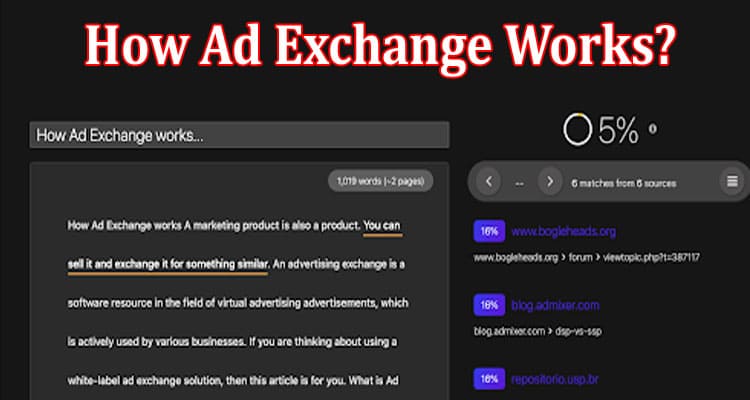How Ad Exchange Works
A marketing product is also a product. You can sell it and exchange it for something similar. An advertising exchange is a software resource in the field of virtual advertising advertisements, which is actively used by various businesses. If you are thinking about using a white-label ad exchange solution, then this article is for you.
What Is an Ad Exchange?
Ad exchange is your autonomous intermediary with a simplified purchasing algorithm. It does not divide the audience into sellers and buyers. There are no transactions between specific individuals here. Both parties are involved in a common Internet space for exchanging marketing content.
Buyer DSP platforms are used by advertising agencies and private traders to place bids on individual display units offered for sale. Sellers, in turn, post the product through AdTech platforms aimed at advertising providers. The buying and selling process takes place through online bidding.
The RTB exchange is built on three pillars:
- advertiser with price;
- rented site;
- an impersonal user with the right to show selected advertising in real-time.
The first advertising exchanges existed independently, and such exchanges still exist today. But in recent years, more and more companies engaged in the AdTech business are introducing exchange functions into their DSP and SSP platforms.
Ad Exchange And Smartphone
RTB advertising exchanges are an automated program resource that provides online auction platforms for third-party sites involved in the advertising network.
Marketing companies and agents with the development of mobile intelligence are increasingly resorting to the mobile software segment, which optimizes exchange processes, thereby leading to increased profits.
Auctions are a 24/7 opportunity for an advertiser to instantly announce starting prices for their product. For a user who visits the main page or application, such a commercial offer is displayed in real time. All information about movements on the part of the user or webmaster is sent to the ad exchange. Bidding is for a single display. The highest bid wins, which is immediately announced by the site.
Who Is Interested In Ad Exchange
Any company with buyer status can purchase advertising products on the advertising exchange:
- Admins and bloggers, speaking through the SSP platform on the part of suppliers, make their advertising field transparent for buyers.
- Independent advertisers, whether agents or individuals, join the ad exchange from a demand position, that is, through the DSP platform.
- Network advertisers acquire a position on the advertising exchange, format the space, and resell it at a profit.
How Does The Advertising Exchange Work?
Using a bidding platform, an advertiser connects directly to the exchange in the hope of getting worthy bidders for the auction for his unsold product. Of course, he wants to get the maximum profit from the implementation of his proposal. For this purpose, he uses the exchange as a kind of optimizer.
Receiving targeted information about the product and potential customers, the exchange not only stores but also targets the data, determining the minimum price of each trade according to several criteria. Thus, it helps the seller quickly find a profitable buyer.
The advertiser is included in the exchange game through the DSP demand platform. This service sorts the desired target audience, configures auction parameters, saves campaign input data, and informs the buyer about each new opportunity to bid.
Ad Exchange Bid Request – What’s Next?
The bid request is activated when the user lands on the publisher’s web property. This signal is recorded on the exchange, along with data on the location and behavioral steps of the user.
The advertiser receives a bid request from the ad exchange. Having collected all the bids, ad exchange gives the victory to the highest bidder. The signal that the auction is completed is returned to the publisher, after which the winning content is displayed on the buyer’s resource.
Ad Exchange And Advertising Network – What’s The Difference?
Consumers often equate advertising exchanges and networks without seeing a significant difference between the two concepts. No wonder. After all, in essence, exchange and network spaces provide the same services: management, as well as the purchase and sale of advertising. However marketing specialists notice that there are, albeit minor, differences in these structures. An experienced player will not miss the chance to use them to his advantage.
Trying to control every little thing, you come across a competitive fuss, similar to children’s games of hide and seek or catch up. In the field of marketing, like in a good movie, many things remain behind the scenes, suspiciously surprise, or leave more questions than answers. But if you lift the veil of scenery, a certain essence is revealed that will tell you who is who.
So:
Difference 1. Purpose.
The advertising network is focused on sales, that is, on the publisher. The advertising exchange remains neutral. This is just a connecting link that helps the seller and buyer find each other in perfect harmony.
Difference 2. Basic model.
What does an advertising network do? It collects advertisements, groups them into categories, and sells them profitably. Advertisers have no idea where their content is being displayed, just as the publisher has no idea whose content they are broadcasting.
Exchange auctions, on the other hand, are transparent. On the exchange, each player can track cash flows on all sites and address information of any supplier or buyer. The parties not only get to know each other more but sometimes even establish personal contacts.
Difference 3. Scale.
The exchange is larger than the network. It’s no secret to advanced marketers that some networks even purchase from exchanges with the right to resell advertising for profit.
Ad exchange provides a lot of opportunities in the advertising market and if you want to dive into this business, we recommend paying attention to the white-label ad exchange solution from SmartHub
Final Thoughts
Ad Exchange allows you to bid and buy advertising space in real-time. This allows advertisers to optimize their campaigns by responding to changes in supply and demand instantly. If you are looking for a white-label ad exchange solution to start such an attractive business, we recommend contacting SmartHub.




